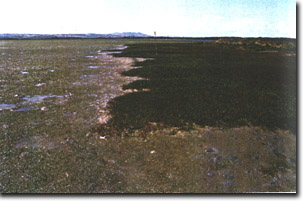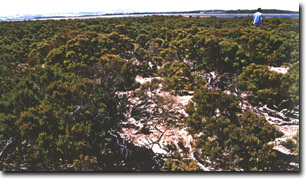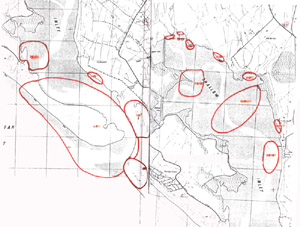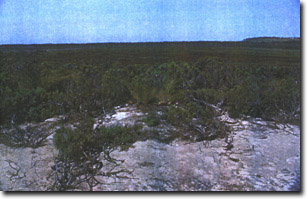6. Marsh Islands
This information has been developed from the publication:
|
| Location | 258034; 265044; 270039; 270044. Central part of Shallow Inlet north-west of Winchesters’. |  Sarcocornia terrace on western marsh island, Shallow Inlet |
Access: | Accessible only by boat. | |
Significant Features: | Four low islands occur in the central part of Shallow Inlet, three on the eastern side of the main channel and the fourth 250 metres west of the channel. Only the western island and the largest eastern island were inspected during this survey. The western island is roughly circular and 350 m in diameter. It is surrounded by a continuous zone of Sarcocornia up to 15 m wide on the sheltered eastern side narrowing to 8 m on the western side. The central part of the island is covered with Sclerostegia with occasional sandy ridges covered with Stipa. The entire edge of the island is stable with no cliffing or recession of the Sarcocornia, although behind the narrow Sarcocornia on the western side there is a low cliff cutting into Stipa. There is no bare mudflat around the island as the Sarcocornia extends directly out to Zostera beds. There are no mangroves. | |
The largest eastern island is 600 m long, averages 100 m wide and is mainly Sarcocornia covered. The western margin is a crescent-shaped sand ridge which is moving into the island as a chenier and covering a narrow zone of Sclerostegia. Sand extends along the northern side of the island. There are many small shallow ponds enclosed in the Sarcocornia. | ||
Significance Level: | Regional. Marsh islands not associated with deltaic growth are unusual in Victoria estuaries and tidal lagoons. The absence of mangroves is striking when compared with the marsh islands in Corner Inlet and Nooramunga. The Shallow Inlet islands are of geomorphological interest for studies in island evolution without accretion around mangroves. | |
Management Issues: | The islands are not compatible with visitor use as wading and tramping across the surface of the tidal flats and saltmarsh causes considerable damage. The marsh surface is easily damaged and boat landing should not be encouraged. | |
Research & Monitoring Requirements: | The islands would be sensitive to changes in the water level and salinity of Shallow Inlet. Mapping of vegetation associations and shoreline area would be of interest in assessing these possible changes in the inlet. | |
Public Interpretation Possibilities: | Not applicable | |
 Sclerostegia in the central part of the western marsh island, Shallow Inlet |  Shallow Inlet (south and north) |  Chenier ridge and Sarcocornia on marsh island, eastern side of main channel, Shallow Inlet. |


